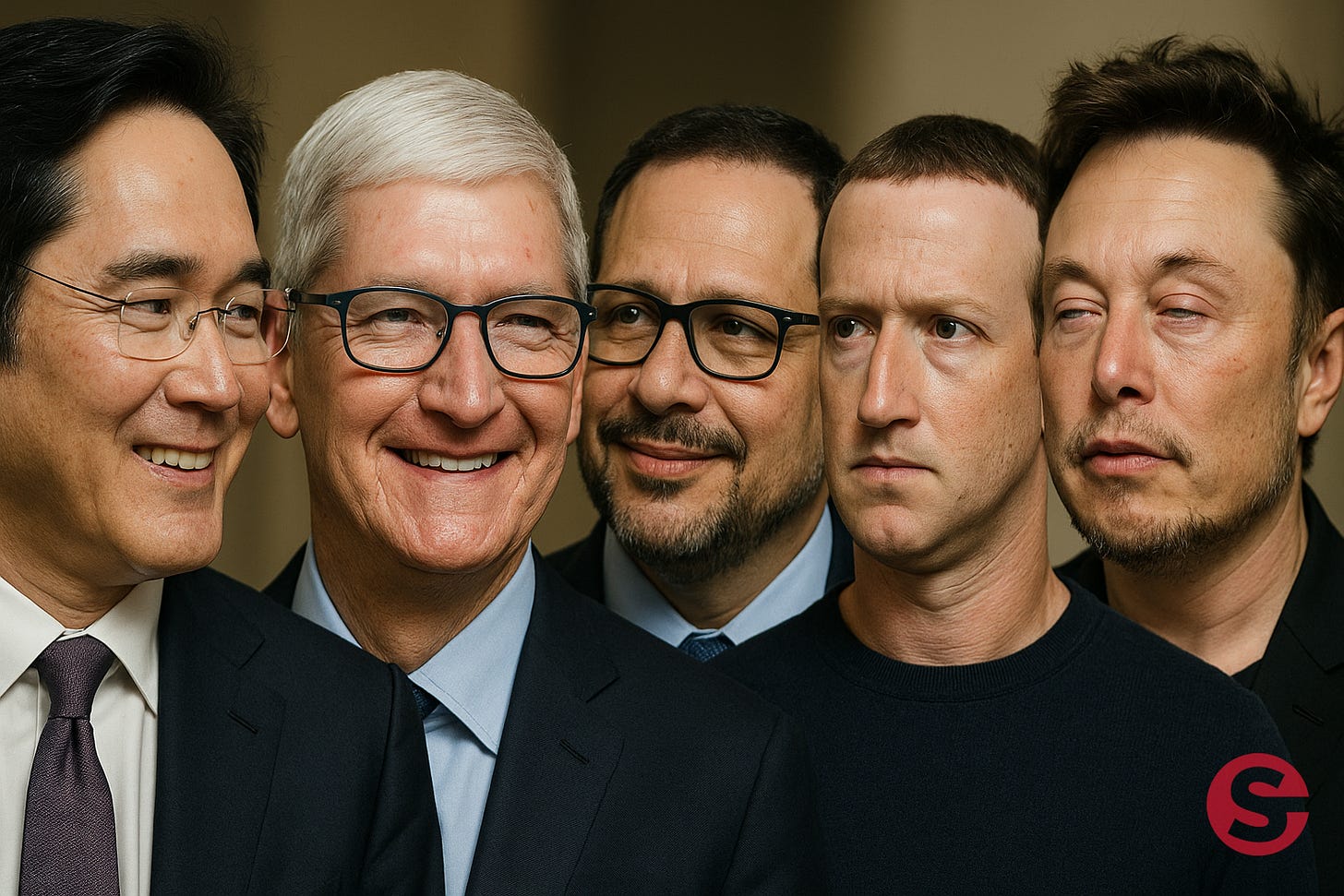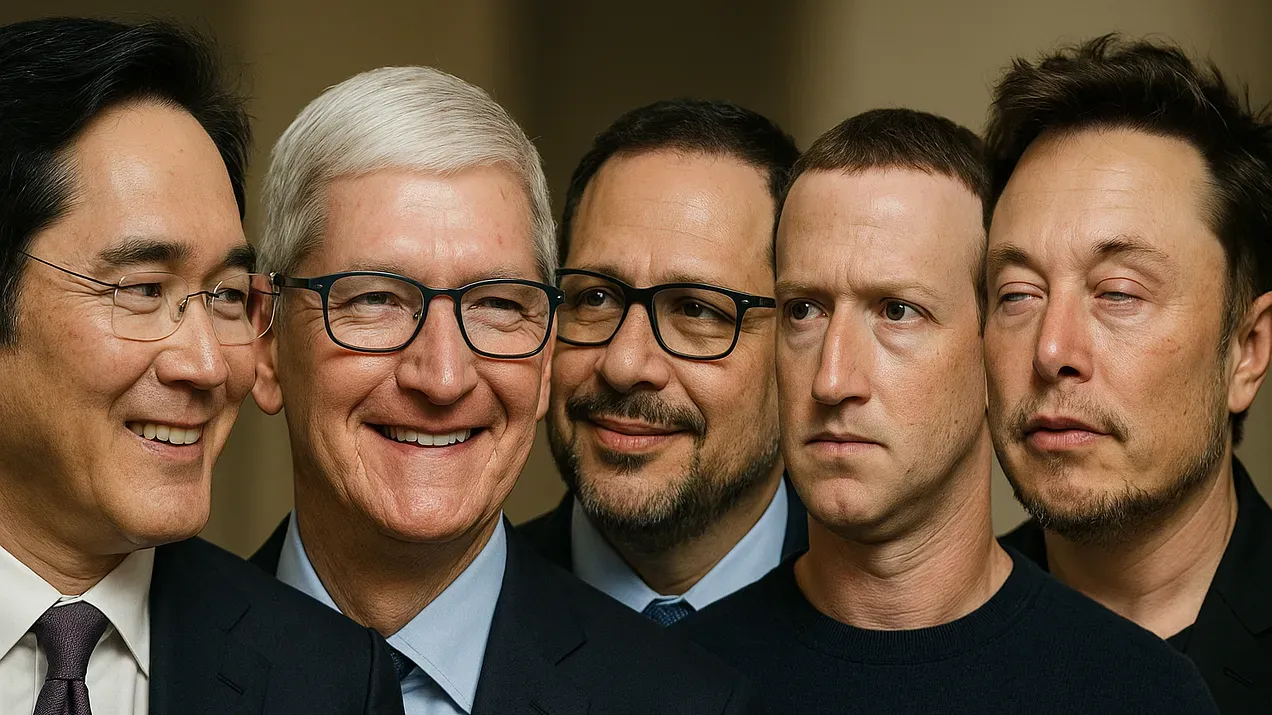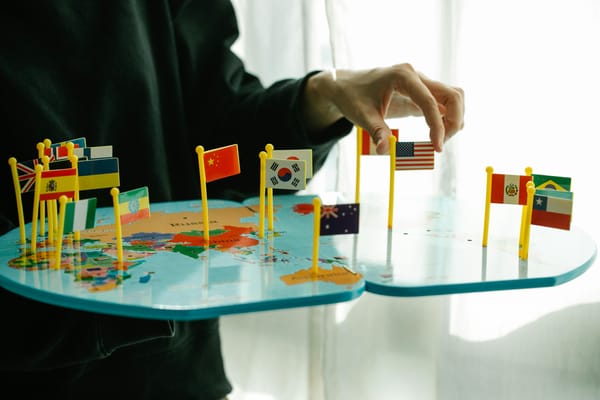TLDR: Rivalry implies separation. But in practice, it often coexists with dependence.
Apple and Samsung spent years in court fighting over smartphone design. At the same time, Apple was one of Samsung’s largest customers, sourcing high volumes of OLED displays for the iPhone.
Apple also sued Qualcomm for anticompetitive licensing practices. A few years later, it paid Qualcomm nearly $5 billion to settle and signed a long-term agreement to keep buying modem chips. There was no substitute.
Qualcomm sells nearly half its chips to Chinese firms, many of which compete with each other and with Qualcomm’s other customers. Some of these clients are subject to export restrictions. That hasn’t meaningfully changed Qualcomm’s revenue mix.
At the same time, some firms refuse to work together, even when cooperation would make economic sense. Meta and Apple operate in overlapping product categories and rely on the same user base. But their approaches to platform control and business model alignment are incompatible. Tesla and legacy automakers avoided each other for years.
These aren’t edge cases. They reflect how competition and interdependence function in today’s supply chains and value chains. Some decisions are made under pressure. Others are made by choice.
For executives, the lesson is not about how to avoid rivalry. It’s about how to operate inside it. Whether the relationship is necessary or intentionally avoided, the same questions apply: Where are the dependencies? What are the tradeoffs? And what breaks if the current arrangement stops working?
At Emerging Strategy, these are the kinds of questions we help executive teams answer, especially when global supply chains, policy environments, or partner dynamics start shifting faster than internal systems are built to respond.

How It Works: Managing Conflict Without Disruption
Firms that compete on the surface often collaborate deeper in the stack. Few companies control all of their inputs. Fewer still can replace a supplier who is the only one capable of delivering at the required quality, quantity, or speed.
When firms are forced to rely on competitors, they build systems around that reality. What allows this to work is not alignment, but structure.
- Functional separation: Legal teams may be managing litigation while procurement and engineering teams continue working with the same firm on product delivery. These efforts are separated internally and bound by process.
- Contract discipline: Commercial relationships between rivals are tightly scoped. Pricing, quality standards, volume expectations, and timelines are fixed. The goal is not to collaborate more—it is to create clarity when trust is limited.
- Tolerance for asymmetry: These relationships are rarely equal. One firm usually benefits more, or controls more leverage. But if the benefit to the other party is still greater than the alternatives, the relationship holds.
No one in these companies describes these partnerships as ideal. But that’s not the goal. The goal is continuity. The systems are built to deliver despite friction.
Samsung and Apple: Litigation and Logistics
Apple and Samsung are direct competitors in the smartphone market. Between them, they control more than a third of global share. They’ve also spent more than a decade fighting over patents, hardware design, and user interface elements.
Yet during the height of that litigation, Samsung was Apple’s primary supplier of OLED screens. In 2017, Samsung supplied displays for the iPhone X. That year, Samsung’s component sales to Apple reportedly generated more revenue than its own flagship phone.
Apple had no viable alternative. Samsung had the manufacturing capability, production scale, and quality controls needed to meet Apple’s product cycle. LG and others were not ready. The choice was to buy from Samsung or delay a major iPhone launch. Apple bought.
Samsung also had no reason to decline. Apple’s orders were large, high-margin, and predictable. Whatever brand tension existed in the marketplace, it did not outweigh the logic of high-volume component sales.
Both sides treated the relationship transactionally. Samsung’s display and handset divisions operate independently. Apple signed a supply agreement with Samsung Display. Legal disputes continued in parallel. Shipments continued on schedule.
This was not a partnership in any strategic sense. It was execution within defined parameters.
Apple and Qualcomm: Legal Strategy Meets Engineering Reality
Apple’s dispute with Qualcomm followed a familiar pattern: accusation of monopoly, refusal to pay royalties, legal countersuits, and a search for an alternate supplier.
Apple attempted to replace Qualcomm by sourcing modem chips from Intel. The plan was to shift future iPhones away from Qualcomm entirely.
Then the roadmap collapsed. Intel’s modem performance lagged. Its 5G timeline slipped. Apple faced the risk of launching a flagship product without next-generation network capabilities. The cost of delay was higher than the cost of settlement.
In 2019, Apple resolved its legal fight with Qualcomm. It paid nearly $5 billion in back payments and agreed to a multi-year licensing and supply agreement. Qualcomm resumed supplying chips.
The case wasn’t resolved through negotiation. It was resolved by time pressure. Apple could not build its own modem fast enough. Intel couldn’t deliver. Qualcomm had leverage because it was the only firm with the right combination of performance and readiness.
This was not an isolated risk. It was a constraint built into Apple’s most important product.
Since then, Apple has continued to invest in in-house modem development. It acquired Intel’s modem business and built teams around wireless integration. But as of 2025, iPhones still ship with Qualcomm chips. That dependency remains in place.
Qualcomm and China: Selling into Volatility
Qualcomm operates under a different kind of exposure. In 2024, nearly 46% of its revenue came from Chinese companies. That includes Xiaomi, Oppo, Vivo, and other OEMs.
This exposure continues despite tightening U.S. export controls and growing restrictions on advanced chip shipments. Qualcomm navigates the restrictions by segmenting its product line, applying for licenses, and designing modified versions of chips that remain compliant.
This strategy is public and legal. It is also vulnerable. Qualcomm’s business in China depends on a policy environment it cannot control. Changes in Washington or Beijing could materially affect its topline.
For now, Qualcomm treats the situation as a constraint to be managed, not a signal to exit. It sells what it is permitted to sell. It adapts features to remain compliant. And it continues to generate a large share of its earnings from companies headquartered in what the U.S. government considers a strategic rival.
The company’s approach reflects a broader trend: in a world of fragmented regulation, execution relies on anticipating what might change, not just optimizing for what exists today.
Companies operating across national boundaries or sensitive sectors increasingly need outside-in intelligence to understand which risks are regulatory, which are operational, and which are just noise. That’s where our work often starts.
Meta and Apple: A Strategic Absence
Most corporate rivalries unfold inside a shared ecosystem: through litigation, licensing, or supply agreements. Meta and Apple are an exception.
Both companies dominate different layers of the consumer tech stack. Apple owns the hardware and operating system. Meta owns several of the most-used mobile apps in the world. Both are investing heavily in the next computing platform—whether that’s mixed reality, spatial computing, or whatever replaces the smartphone.
They operate next to each other. But they don’t work together. At all.
This wasn’t always the case. Meta’s platforms—Facebook, Instagram, WhatsApp—relied heavily on Apple’s App Store infrastructure. That relationship was standard, commercial, and largely invisible to users.
Then Apple changed the rules.
In 2021, Apple rolled out App Tracking Transparency, a privacy policy shift that gave users the option to block cross-app tracking. The change severely impacted Meta’s ad-targeting model and cut into its revenue. Meta opposed the move publicly and aggressively. Apple framed it as a consumer rights issue.
The fallout was structural. Meta began to reposition itself around hardware and immersive platforms (Quest, Ray-Ban Meta, Horizon). Apple built its own entry into the same space with Vision Pro. Any residual alignment disappeared.
Today, the two companies build for the same user base, but with incompatible models. Apple optimizes for closed systems, device margins, and consumer privacy. Meta depends on open data flows, advertising yield, and time spent across apps.
From a business standpoint, there are places where cooperation would make sense. Shared standards in mixed reality. Interoperability in messaging. Distribution efficiency across platforms. None of it happens.
Not because the economics aren’t viable. But because the relationship is strategically and philosophically unworkable.
Both companies treat the absence as preferable to entanglement. Each is betting on controlling the user’s future environment. The costs of compromise are seen as greater than the benefits of short-term alignment.
This is intentional distance.
Tesla and Traditional Automakers: Reluctant Convergence
For years, Tesla and legacy automakers avoided each other. The logic was mutual.
Tesla positioned itself as a break from the automotive establishment—not just in product, but in philosophy. Vertical integration, direct-to-consumer sales, proprietary infrastructure. Its success was framed as a referendum on everything its competitors represented.
Legacy firms responded in kind. They viewed Tesla as both a threat and an outlier. Collaborating would mean conceding ground in a market they once owned outright. For most, that was a step too far.
This mutual distance came at a cost. Tesla’s charging network was more reliable and better distributed than the alternatives. But it remained a closed system. Traditional automakers built out their own networks, often in fragmented partnerships, with uneven results.
By 2023, that began to shift.
Tesla’s North American Charging Standard (NACS) gained traction. Ford, GM, and others agreed to adopt the standard and give their drivers access to the Supercharger network. The change was practical. The alternative—building a parallel network with inferior performance—was harder to justify.
Even so, the collaboration remains narrow. There is no joint development of powertrains, platforms, or battery systems. No shared investment in factories or software ecosystems. The decision to align on charging is transactional.
The relationship is still shaped by distance. Legacy OEMs want the benefits of infrastructure access without becoming dependent. Tesla wants the revenue from charging access without changing its posture. Both sides appear comfortable keeping it limited.
The result is a partial convergence. It solves a specific pain point, but it doesn’t change the structure of the rivalry. Each side still plans to win on its own terms.
This is deliberate calculation about where to draw the line.
What This Tells Executives About Strategy and Exposure
The companies in these cases operate in different sectors with different constraints. Some work with their rivals by necessity. Others avoid it on principle. What matters isn’t the consistency—it’s the structure behind the decision.
Where cooperation does exist, it’s managed. These firms separate conflict from continuity. They build operational systems that allow them to rely on firms they also compete with—or litigate against. They don’t assume alignment. They work around it.
Where cooperation doesn’t exist, the decision is often strategic. Meta and Apple could share standards, licensing, or platform infrastructure. They don’t—because doing so would compromise control over core business models. The absence is deliberate.
For executive teams, the pattern isn’t about preference. It’s about preparation. Whether the relationship exists or not, the risk still has to be understood.
1. Separate what you control from what you rely on
Apple’s legal strategy against Samsung didn’t prevent it from shipping a product. That separation required clear lines between legal, procurement, and engineering. Structure, not sentiment, kept the product cycle intact.
2. Dependency is rarely symmetrical
Qualcomm sells into China because that’s where the market is. But that exposure also puts nearly half its revenue at the mercy of external policy shifts. It’s not enough to know who you depend on. You need to understand who depends on you—and who doesn’t.
3. Technical constraints override legal plans
Apple’s attempt to switch away from Qualcomm failed when Intel couldn’t deliver on time. That wasn’t a legal failure. It was a mismatch between ambition and engineering capacity. The timeline for strategy is often shorter than the timeline for substitution.
4. Resilience needs a shorter runway
It’s easy to say you have a contingency plan. It’s harder to execute one in real time. A backup that takes years to activate isn’t a backup. It’s an aspirational roadmap. The only viable plan is one that can absorb pressure without blowing your delivery schedule.
5. Refusal to engage has a cost
Meta and Apple chose not to work together. The decision is understandable. But it comes with tradeoffs: duplicated R&D, fractured standards, and friction at scale. These aren’t minor. Avoiding dependency creates a different set of vulnerabilities—just less visible ones.
We’ve worked with firms navigating both types of exposure: those entangled with rivals, and those trying to stay clear. In either case, clear-eyed mapping of risk is the first step.
Rivalry Comes in Two Forms: Managed or Avoided
Some companies compete and cooperate at the same time. Others keep their distance. Both are forms of strategy. Both require structure.
In either case, the test for leadership isn’t whether your company has adversaries. It’s whether you understand the nature of your exposure—and whether you’re prepared to operate through it.
There is no neutral position anymore. Interdependence is a constraint. So is isolation. The difference is that one forces you to manage the relationship. The other forces you to build around it.
Either way, waiting for alignment is not a strategy. Knowing where your risks are—and being ready to absorb them—is.
Especially when the firm you can’t avoid may also be the one you can’t trust.







